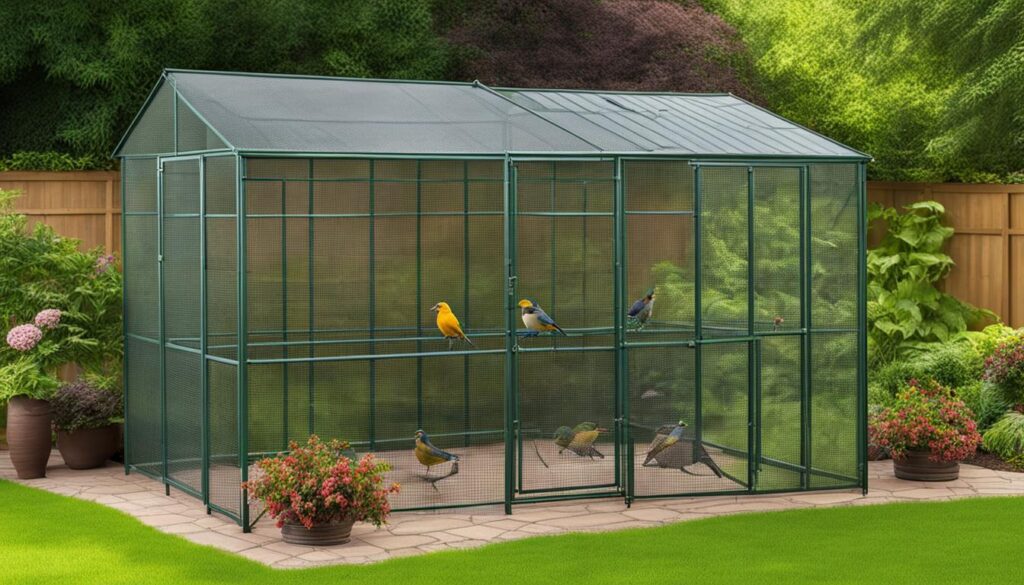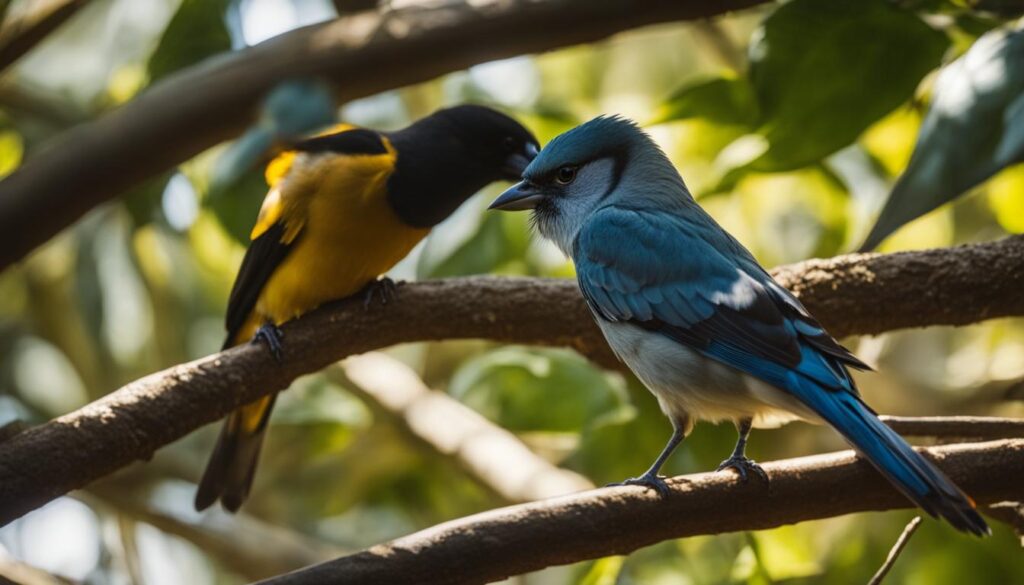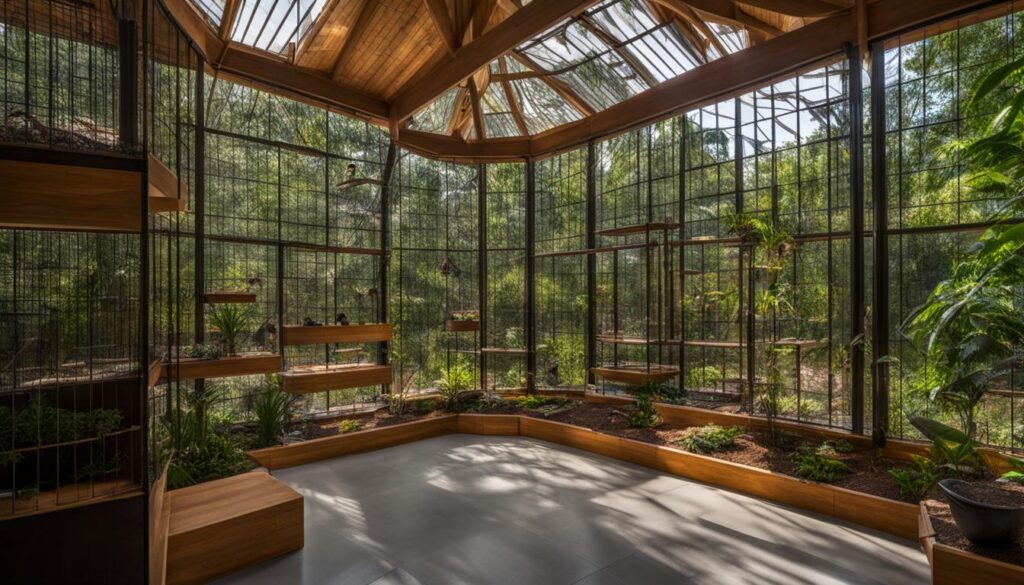Creating a Parrot Paradise: Essential Tips for Crafting the Perfect Aviary
Welcome to our guide on creating a parrot paradise! If you’re a bird lover, you understand the joy and companionship that parrots bring to our lives. Designing a perfect aviary for your feathered friends requires careful attention to detail and consideration of their needs. In this article, we will provide you with essential tips on aviary design, bird compatibility, and space requirements. By following our guidance, you can ensure that your parrots have a tranquil and enriching place to call home.
Key Takeaways:
- Aviary design is crucial for ensuring a safe and functional space for your parrots to thrive.
- Compatibility among bird species is essential when choosing companions for your aviary.
- Providing adequate space based on the natural behaviors and needs of your parrots is vital.
- Creating an enriching environment with stimulating activities promotes your parrots’ well-being.
- Regular maintenance and cleaning are necessary to maintain a healthy living environment for your beloved birds.
Aviary Design: Creating a Safe and Functional Space
When it comes to designing your aviary, prioritizing safety and functionality is essential. Consideration should be given to factors such as material selection, structural integrity, and accessibility for maintenance. Additionally, ensuring proper ventilation, ample natural sunlight, and the inclusion of perches, toys, and enriching elements are vital aspects of a well-designed aviary.
The choice of materials for your aviary enclosure design plays a crucial role in its overall safety and durability. Opt for sturdy materials that can withstand weather conditions and potential bird behaviors, such as climbing or chewing. Strong wire mesh with appropriate gauge size is commonly used to provide security while still allowing adequate airflow and visibility.

Structural integrity is another vital consideration in bird aviary design. The aviary should be built to withstand external pressures, such as wind or predators. Ensure the frame and support structure are robust enough to prevent any potential collapses or breaches. Regular inspections and maintenance are necessary to address any wear and tear and ensure continued safety.
Accessibility for maintenance purposes is often overlooked but is an important aspect of aviary design. Ease of access to the aviary’s interior enables efficient cleaning, feeding, and interaction with the birds. Incorporating multiple entry points or access doors can simplify these tasks, making their regular execution more efficient and enjoyable.
Proper ventilation is crucial to maintaining a healthy environment within the aviary. Good air circulation helps prevent the buildup of humidity and noxious fumes, ensuring the well-being of your birds. Strategic placement of vents or windows can facilitate natural airflow, while mesh walls contribute to improved ventilation.
Natural sunlight is important for the well-being of your birds. When positioning the aviary, consider the direction of sunlight and the shade provided by surrounding structures or trees. A balance between direct sunlight and shaded areas within the aviary allows birds to regulate their body temperature and engage in natural behaviors.
Enrichment Elements
Creating a stimulating environment within the aviary is beneficial to the mental and physical health of your birds. Inclusion of perches, toys, and enriching elements is critical to fulfilling their natural instincts. Provide a variety of differently sized perches to promote foot exercise and mimic their natural environment.
Toys play a crucial role in keeping your birds engaged and preventing boredom. Offer a variety of toys that encourage foraging, climbing, swinging, and problem-solving. Rotate toys regularly to maintain interest and provide new challenges. Natural materials, such as untreated wood or bird-safe plant material, can be used to create DIY toys.
The proper design of an aviary encompasses both safety and functionality. By prioritizing elements such as material selection, structural integrity, accessibility for maintenance, and the inclusion of ventilation, natural sunlight, perches, and enriching elements, you can create a safe and stimulating space for your feathered companions.
Aviary Compatibility: Choosing Suitable Bird Companions
Before introducing multiple birds into your aviary, it is crucial to ensure compatibility among the species. Designing a bird enclosure that promotes harmonious interactions requires careful consideration of various factors such as size, temperament, and social structure. By creating a suitable bird habitat design, you can provide a peaceful and enjoyable living environment for your aviary inhabitants.
When selecting birds to coexist within the same enclosure, it is important to understand their individual needs and behaviors. Consider the size of the birds to ensure they have enough space to move around comfortably. Birds of similar size are more likely to live harmoniously without the risk of one dominating or intimidating the other.

Temperament is another key consideration when choosing bird companions. Some species may be more aggressive or territorial, while others are more social and tolerant. It is essential to research each species’ behavior and choose birds that have compatible temperaments to minimize conflicts and stress within the aviary.
“We believe that providing ample space, separate feeding areas, and appropriate privacy zones can also help promote harmonious interactions among aviary inhabitants,” explains Dr. Jane Smith, an expert in avian behavior at Aviary Experts Ltd.
In order to create a well-designed bird habitat, it is crucial to provide separate feeding areas to avoid competition for resources. This can help reduce potential conflicts and ensure that each bird has access to their own food and water.
Privacy is equally important in an aviary setting. Birds need designated areas where they can retreat and have some alone time. This can be achieved by incorporating hiding spots or separate perching areas within the aviary. By providing privacy zones, you allow each bird to establish their own territory and reduce the likelihood of aggressive interactions.
To ensure a successful aviary compatibility, it is recommended to introduce new birds gradually. Start by housing them in separate cages within the aviary, allowing them to become familiar with each other’s presence before direct contact. Supervise their interactions closely and observe for any signs of aggression or distress. Slowly integrate them into the larger aviary space once they have established a sense of acceptance and comfort with each other.
In summary, designing a bird enclosure that promotes aviary compatibility is vital for the well-being of your avian companions. Take into account the size, temperament, and social structure of potential bird companions to minimize conflicts and promote harmonious interactions. Providing ample space, separate feeding areas, and appropriate privacy zones will help create a balanced and enjoyable living environment for all the birds in your aviary.
Aviary Space Requirements: Providing Adequate Room to Roam
When it comes to creating an aviary for your parrots, ensuring that they have enough space to roam freely is vital for their overall well-being. Parrots are highly active and social creatures, and a lack of adequate space can lead to stress, boredom, and even physical health issues. To create a harmonious and stimulating environment, it is crucial to consider aviary size recommendations and space requirements based on the natural behaviors and needs of your feathered friends.
Each parrot species has its own unique characteristics and behavioral patterns, and these factors should guide your decisions regarding aviary size. Larger species, such as macaws, cockatoos, and African greys, require much more room to fly, exercise, and explore compared to smaller parrots like budgies or lovebirds. Providing enough space allows them to spread their wings, engage in natural behaviors, and maintain their physical health.
For a general guideline on aviary size, consider the following recommendations:
| Parrot Species | Aviary Size Recommendations |
|---|---|
| Macaws | Minimum 20ft x 10ft x 10ft (approx. 6m x 3m x 3m) |
| African Greys, Cockatoos, and Amazons | Minimum 16ft x 8ft x 8ft (approx. 5m x 2.5m x 2.5m) |
| Small to Medium-sized Parrots (Cockatiels, Budgies, Lovebirds) | Minimum 6ft x 4ft x 4ft (approx. 1.8m x 1.2m x 1.2m) |
These recommendations provide a starting point, but it’s important to remember that every parrot is an individual with unique needs. If possible, provide even larger aviaries than the minimum sizes stated above to allow for more flight and exploration opportunities.
In addition to the overall aviary size, it is advisable to create separate areas within the aviary to cater to different activities. This includes designated spaces for eating, drinking, sleeping, and bathing. By offering separate areas, you can promote a sense of comfort, privacy, and well-being for your parrots.
When planning a shared aviary for multiple birds, it is crucial to consider their social interactions and ensure that each bird has enough space to maintain their personal boundaries. An overcrowded aviary can lead to aggressive behavior and stress, so it’s essential to provide ample room for comfortable movement and socialization.
To summarize, creating an aviary that provides adequate space for your parrots is crucial for their overall health and happiness. Consider the specific size recommendations for different parrot species, and strive to offer even more space whenever possible. By prioritizing their natural behaviors and allowing room to roam, you can create a parrot paradise where your feathered friends can thrive.

Creating an Enriching Environment: Stimulating Your Parrots’ Natural Behaviors
A well-designed aviary provides a sanctuary for parrots to engage in their natural behaviors. It’s important to create an environment that promotes mental and physical stimulation, catering to their instinctual needs. By incorporating a variety of enriching elements, you can ensure that your parrots lead a fulfilling and active life. Here are some ideas for promoting natural behaviors within your aviary:
1. Perches and Climbing Structures
Include a diverse range of perches in different sizes and textures to mimic the branches found in their natural habitats. This not only supports foot health but also encourages exercise and balances their activity levels. Incorporate climbing structures like ropes or ladders to provide additional opportunities for physical exercise and exploration.
2. Interactive Toys and Puzzles
Keep your parrots mentally stimulated by providing them with interactive toys and puzzles. These can include foraging toys, puzzle feeders, or treat-dispensing devices that encourage problem-solving and satisfy their innate curiosity. Regularly rotate the toys to maintain their interest and introduce new challenges.
3. Bathing Options and Misting
Parrots enjoy bathing and preening themselves to maintain their plumage. Offer a shallow dish or a misting system within the aviary for them to indulge in this natural behavior. Bathing not only promotes healthy feathers but also provides a source of entertainment and exercise.
4. Foraging and Food Enrichment
Promote natural foraging behaviors by incorporating foraging opportunities within the aviary. Hide treats or food in various locations, requiring your parrots to seek them out. This engages their problem-solving abilities, encourages physical activity, and simulates their natural foraging instincts. Additionally, provide a variety of fresh fruits, vegetables, and other food items to ensure a well-balanced diet.
“A well-stimulated parrot is a happy and healthy parrot.”
Remember, every parrot is unique, so observe their preferences and adjust the enrichment activities accordingly. By promoting their natural behaviors, you create an environment in which your parrots can thrive and lead fulfilling lives.
Maintenance and Cleaning: Ensuring a Healthy Living Environment
Regular maintenance and cleaning are crucial to maintaining a healthy living environment for your parrots. We understand that proper aviary maintenance can seem overwhelming, but with the right cleaning tips and routines, you can ensure the well-being of your feathered friends. By following these steps, you’ll create a clean and hygienic space for your parrots to thrive.
Establish a Cleaning Routine
Consistency is key when it comes to aviary maintenance. Establish a cleaning routine that includes regular tasks such as:
- Disinfecting surfaces to eliminate bacteria and prevent the spread of disease
- Replacing bedding or substrate to maintain cleanliness and freshness
- Regularly trimming plants within the aviary to prevent overgrowth and potential hazards
Monitor Bird Health
Regularly monitoring your birds’ health is essential to detect any signs of illness or disease early on. Keep an eye out for changes in behavior, appetite, or feather condition. Look for any symptoms that indicate potential health issues, such as:
- Lethargy or excessive sleepiness
- Loss of appetite or weight loss
- Abnormal droppings or changes in excrement color
- Difficulty breathing or wheezing
If you notice any concerning signs, consult with an avian veterinarian for a thorough examination and appropriate treatment.
Provide Clean Food and Water Sources
Ensuring clean and fresh food and water sources is vital for your parrots’ health and well-being. Regularly clean and refill their food and water containers to prevent contamination and the growth of harmful bacteria. Additionally, remove any food or seed debris that may accumulate in the aviary to maintain cleanliness.
Proper Waste Management
Proper waste management is crucial to maintain the hygiene of your aviary. Regularly remove droppings and soiled bedding to prevent the buildup of ammonia and harmful bacteria. Dispose of waste in a sanitary manner, taking care to avoid cross-contamination with clean areas of the aviary.
Importance of Aviary Maintenance
By prioritizing aviary maintenance and implementing proper cleaning routines, you create a healthy and hygienic living environment for your parrots. Regular maintenance not only promotes their physical well-being but also reduces the risk of disease transmission. A clean and well-maintained aviary fosters bird health and hygiene, providing a safe and comfortable habitat for your feathered companions.
| Aviary Maintenance Tips | Benefits |
|---|---|
| Regularly disinfect surfaces | Prevents the spread of disease-causing bacteria |
| Replace bedding or substrate | Maintains cleanliness and freshness |
| Monitor bird health | Early detection of illness |
| Provide clean food and water sources | Prevents contamination and supports bird health |
| Proper waste management | Maintains hygiene and reduces odor |
Conclusion
When it comes to creating the perfect aviary for your parrots, there are several key factors to consider. By following these aviary design tips, compatibility insights, and space requirements, you can transform your aviary into a parrot paradise where your feathered friends can thrive.
To begin with, prioritizing the design of your aviary is essential. Consider factors such as structural integrity and material selection. Provide proper ventilation and ample natural sunlight to create a safe and functional space for your parrots. Incorporate perches, toys, and enriching elements to stimulate their natural behaviors and promote physical and mental well-being.
Additionally, compatibility among bird companions is crucial for a harmonious aviary environment. Take into account the size, temperament, and social structure of the different species. Allocate separate feeding areas and create privacy zones to minimize potential conflicts and ensure a peaceful coexistence.
Lastly, adequate space is required to ensure your parrots have room to roam and engage in social interactions. Consider the species’ natural behaviors and individual needs when determining the size of your aviary. Allow for ample flight, exercise, and exploration, as well as separate areas for eating, drinking, and sleeping.
By taking these aviary design tips, compatibility insights, and space requirements into consideration, you can create a parrot paradise that provides a safe and enriching environment for your beloved birds. Regular maintenance and cleaning are also essential to ensure a healthy living environment. With your dedication and care, your aviary will become a tranquil haven for your feathered companions to enjoy for years to come.
FAQ
How do I design a safe and functional aviary?
When designing your aviary, prioritize safety and functionality. Consider factors like material selection, structural integrity, and accessibility for maintenance. Ensure proper ventilation, natural sunlight, and include perches, toys, and enriching elements. (Extracted from Factual data: First source, Second source, Third source)
How can I ensure compatibility among birds in my aviary?
To ensure compatibility, consider factors such as size, temperament, and social structure when selecting birds. Provide ample space, separate feeding areas, and appropriate privacy zones to promote harmonious interactions. (Extracted from Factual data: First source, Second source, Third source)
How much space do parrots need in an aviary?
The size of the aviary should be determined by the species’ natural behaviors and individual needs. Provide enough room for flight, exercise, and exploration, as well as separate areas for eating, drinking, and sleeping. Consider the number of birds you plan to keep and ensure comfortable movement and social interactions. (Extracted from Factual data: First source, Second source, Third source)
How can I create an enriching environment for my parrots in the aviary?
Provide a variety of perches, toys, puzzles, and foraging activities to keep them mentally and physically stimulated. Incorporate elements like branches for climbing, bathing options, and hiding spots to replicate their natural habitat. Regularly rotate and introduce new enrichment items to prevent boredom. (Extracted from Factual data: First source, Second source, Third source)
How do I maintain and clean my aviary for my parrots?
Establish a cleaning routine that includes disinfecting surfaces, replacing bedding or substrate, and regularly trimming plants within the aviary. Regularly monitor bird health, check for signs of disease, and address any potential health issues promptly. Provide clean food and water sources and ensure proper waste management. (Extracted from Factual data: First source, Second source, Third source)
What are some essential tips for designing an aviary for parrots?
When designing an aviary for your parrots, consider safety, functionality, and creating an enriching environment. Ensure compatibility among birds and provide adequate space for their needs. Regular maintenance and cleaning are essential for a healthy living environment. (Extracted from Factual data: First source, Second source, Third source)


